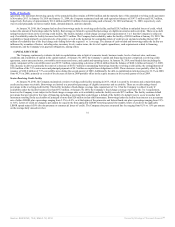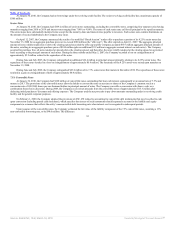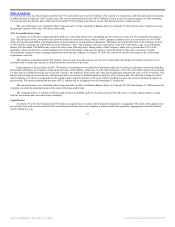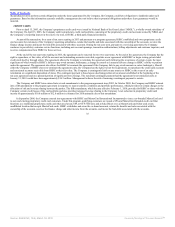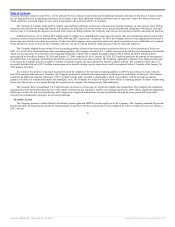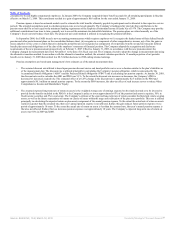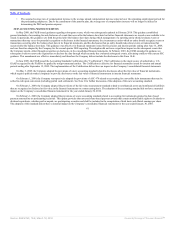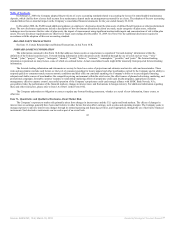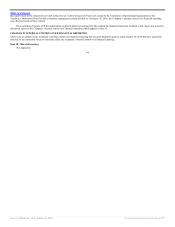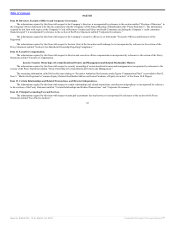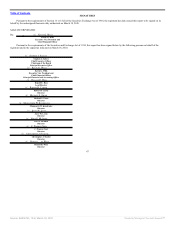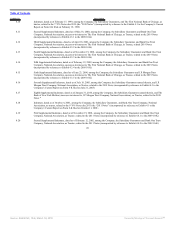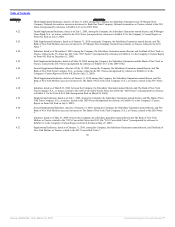Saks Fifth Avenue 2009 Annual Report Download - page 42
Download and view the complete annual report
Please find page 42 of the 2009 Saks Fifth Avenue annual report below. You can navigate through the pages in the report by either clicking on the pages listed below, or by using the keyword search tool below to find specific information within the annual report.
Table of Contents
considered to be non-highly compensated employees. In January 2009, the Company suspended future benefit accruals for all remaining participants in the plan
effective on March 13, 2009. This curtailment resulted in a gain of approximately $0.6 million for the year ended January 31, 2009.
Pension expense is based on actuarial models used to estimate the total benefits ultimately payable to participants and is allocated to the respective service
periods. The actuarial assumptions used to calculate pension costs are reviewed annually. The Company’s funding policy provides that contributions to the
pension trusts shall be at least equal to the minimum funding requirement of the Employee Retirement Income Security Act of 1974. The Company may provide
additional contributions from time to time, generally not to exceed the maximum tax-deductible limitation. The pension plans are valued annually as of the
Company’s fiscal year-end balance sheet date. The projected unit credit method is utilized in recognizing the pension liabilities.
In September 2006, the FASB issued a new accounting pronouncement which requires employers to (i) recognize the funded status of their defined benefit
pension and other postretirement plans on the consolidated balance sheet, (ii) recognize as a component of other comprehensive income, net of tax, the gains or
losses and prior service costs or credits that arise during the period but are not recognized as components of net periodic benefit cost and (iii) measure defined
benefit plan assets and obligations as of the date of the employer’s statement of financial position. The Company adopted the recognition and disclosure
requirements of the new pronouncement prospectively on February 3, 2007. Effective January 31, 2009, in accordance with the new pronouncement, the
Company changed its measurement date from November 1 to the date of its fiscal year end. The Company elected to adopt the change in measurement date using
the alternative transition method. In accordance with the alternative transition method, the actuarial valuation provided a 15-month projection of net periodic
benefit cost to January 31, 2009 that resulted in a $0.3 million decrease to 2008 ending retained earnings.
Pension assumptions are based upon management’s best estimates as of the annual measurement date.
• The assumed discount rate utilized is based upon pension discount curves and bond portfolio curves over a duration similar to the plan’s liabilities as
of the measurement date. The discount rate is utilized principally in calculating the Company’s pension obligation, which is represented by the
Accumulated Benefit Obligation (“ABO”) and the Projected Benefit Obligation (“PBO”) and in calculating net pension expense. At January 30, 2010,
the discount rate used to calculate the ABO and PBO was 5.1%. To the extent the discount rate increases or decreases, the Company’s PBO is
decreased or increased, respectively. The estimated effect of a 0.25% change in the discount rate is approximately $2.3 million on the PBO and
approximately $0.1 million on annual pension expense. To the extent the PBO increases, the after-tax effect of such increase serves to reduce Other
Comprehensive Income and Shareholders’ Equity.
• The assumed expected long-term rate of return on assets is the weighted average rate of earnings expected on the funds invested or to be invested to
provide for the benefits included in the PBO. It is the Company’s policy to invest approximately 65% of the pension fund assets in equities, 30% in
fixed income securities and 5% in real estate. The Company’s estimate of the expected long-term rate of return considers the historical returns on plan
assets, as well as the future expectations of returns on classes of assets within the target asset allocation of the plan asset portfolio. This rate is utilized
principally in calculating the expected return on plan assets component of the annual pension expense. To the extent the actual rate of return on assets
realized is greater than the assumed rate, that year’s annual pension expense is not affected. Rather, this gain reduces future pension expense over a
period of approximately 10 years. To the extent the actual rate of return on assets is less than the assumed rate, that year’s annual pension expense is
likewise not affected. Rather, this loss increases pension expense over approximately 10 years. The Company’s expected long-term rate of return on
assets was 8.0% in 2009 and 2008.
40
Source: SAKS INC, 10-K, March 18, 2010 Powered by Morningstar® Document Research℠



